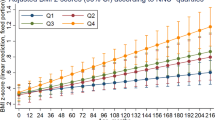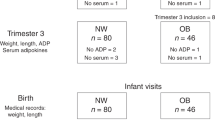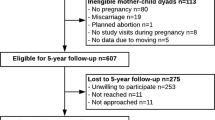Abstract
Background/objectives:
Overweight and obesity are becoming increasingly prevalent problems worldwide. A number of factors in early life have been found to be associated with body composition of neonates or young children but there is limited follow-up data for adolescents. This study aims to describe associations between early nutrition and body composition in adolescents.
Subjects/methods:
Birth cohort study of 415 pregnant women and their offspring (mean age 16 years). Body composition including fat mass (FM) and lean body mass (LBM) of adolescents at 16 years of age was measured by dual-energy X-ray absorptiometry. Information on maternal food and nutrients intake during the third trimester of pregnancy and breastfeeding was collected by questionnaires soon after birth.
Results:
A total of 264 mother–adolescents pairs were studied. Maternal antenatal meat intake was positively associated with FM of adolescents (an increase of 0.9%/portion, P<0.01). There were also positive associations between maternal energy intake (per 1000 kJ/day), fat (per 10 g/d) and protein (per 10 g/day) intake and offspring’s FM (an increase of 1.3%), but these became borderline after adjustment for confounders. Breastfeeding >25 days was negatively associated with FM in adolescents (a decrease of 14%, P=0.01). These associations were independent of the significant association between maternal energy and macronutrient intakes during pregnancy and adolescent intakes at 16 years of age. No significant association was found between maternal dietary intake and lean mass in adolescents.
Conclusions:
Breastfeeding may have a biological effect that is beneficial for the prevention of obesity. Conversely, higher maternal meat intake during pregnancy may increase FM in adolescents.
This is a preview of subscription content, access via your institution
Access options
Subscribe to this journal
Receive 12 print issues and online access
$259.00 per year
only $21.58 per issue
Buy this article
- Purchase on Springer Link
- Instant access to full article PDF
Prices may be subject to local taxes which are calculated during checkout
Similar content being viewed by others
References
Cretikos MA, Valenti L, Britt HC, Baur LA . General practice management of overweight and obesity in children and adolescents in Australia. Med Care 2008; 46: 1163–1169.
Budge H, Gnanalingham MG, Gardner DS, Mostyn A, Stephenson T, Symonds ME . Maternal nutritional programming of fetal adipose tissue development: long-term consequences for later obesity. Birth Defects Res C Embryo Today 2005; 75: 193–199.
Swinburn B, Egger G . The runaway weight gain train: too many accelerators, not enough brakes. BMJ 2004; 329: 736–739.
Martorell R, Stein AD, Schroeder DG . Early nutrition and later adiposity. J Nutr 2001; 131: 874S–880S.
McMillen IC, MacLaughlin SM, Muhlhausler BS, Gentili S, Duffield JL, Morrison JL . Developmental origins of adult health and disease: the role of periconceptional and foetal nutrition. Basic Clin Pharmacol Toxicol 2008; 102: 82–89.
Harvey NC, Poole JR, Javaid MK, Dennison EM, Robinson S, Inskip HM et al. Parental determinants of neonatal body composition. J Clin Endocrinol Metab 2007; 92: 523–526.
Tamashiro KL, Terrillion CE, Hyun J, Koenig JI, Moran TH . Prenatal stress or high-fat diet increases susceptibility to diet-induced obesity in rat offspring. Diabetes 2009; 58: 1116–1125.
Buckley AJ, Keserü B, Briody J, Thompson M, Ozanne SE, Thompson CH . Altered body composition and metabolism in the male offspring of high fat-fed rats. Metabolism 2005; 54: 500–507.
Gale CR, Javaid MK, Robinson SM, Law CM, Godfrey KM, Cooper C . Maternal size in pregnancy and body composition in children. J Clin Endocrinol Metab 2007; 92: 3904–3911.
Brion MJ, Ness AR, Rogers I, Emmett P, Cribb V, Davey Smith G et al. Maternal macronutrient and energy intakes in pregnancy and offspring intake at 10 y: exploring parental comparisons and prenatal effects. Am J Clin Nutr 2010; 91: 748–756.
Jones G, Riley MD, Dwyer T . Maternal diet during pregnancy is associated with bone mineral density in children: a longitudinal study. Eur J Clin Nutr 2000; 54: 749–756.
Jones G, Riley M, Dwyer T . Breastfeeding in early life and bone mass in prepubertal children: a longitudinal study. Osteoporos Int 2000; 11: 146–152.
Yin J, Dwyer T, Riley M, Cochrane J, Jones G . The association between maternal diet during pregnancy and bone mass of the children at age 16. Eur J Clin Nutr 2010; 64: 131–137.
Ponsonby AL, Dwyer T, Kasl SV, Cochrane JA, Newman NM . An assessment of the impact of public health activities to reduce the prevalence of the prone sleeping position during infancy: the Tasmanian Cohort Study. Prev Med 1994; 23: 402–408.
Baghurst K, Record S . A computerised dietary analysis system for use with diet diaries or food frequency questionnaires. Community Health Stud 1984; 8: 11–18.
Ambrosini GL, van Roosbroeck SA, Mackerras D, Fritschi L, de Klerk NH, Musk AW . The reliability of ten-year dietary recall: implications for cancer research. J Nutr 2003; 133: 2663–2668.
Hodge A, Giles GG, Patterson A, Brown W, Ireland P . The Anti-Cancer Council of Victoria FFQ. Relative validity of nutrient intakes compared with diet diaries in young of middle-aged women in a study of iron supplementation. Aust NZ J Public Health 2000; 24: 576–583.
Pryer JA, Vrijheid M, Nichols R, Kiggins M, Elliott P . Who are the 'low energy reporters' in the dietary and nutritional survey of British adults? Int J Epidemiol 1997; 26: 146–154.
Australia Government, Department of Health and Ageing, National Health and Medical Research Council. Nutrient Reference Values for Australia and New Zealand Including Recommended Dietary Intakes. Commonwealth: Australia,, 2005 p 6.
Black AE, Cole TJ . Within- and between-subject variation in energy expenditure measured by the doubly-labelled water technique: implications for validating reported dietary energy intake. Eur J Clin Nutr 2000; 54: 386–394.
Torun B . Energy requirements of children and adolescents. Public Health Nutr 2005; 8: 968–993.
Dwyer T, Ponsonby AL, Newman NM, Gibbons LE . Prospective cohort study of prone sleeping position and sudden infant death syndrome. Lancet 1991; 337: 1244–1247.
Cole TJ, Bellizzi MC, Flegal KM, Dietz WH . Establishing a standard definition for child overweight and obesity worldwide: international survey. BMJ 2000; 320: 1240–1243.
Schall JI, Semeao EJ, Stallings VA, Zemel BS . Self-assessment of sexual maturity status in children with Crohn's disease. J Pediatr 2002; 141: 223–229.
Aaron DJ, Kriska AM, Dearwater SR, Cauley JA, Metz KF, LaPorte RE . Reproducibility and validity of an epidemiologic questionnaire to assess past year physical activity in adolescents. Am J Epidemiol 1995; 142: 191–201.
Ajmani V Applied Econometrics Using the SAS System. John Wiley & Sons, Inc.: Hoboken, NJ, 2009.
Willett WC, Howe GR, Kushi LH . Adjustment for total energy intake in epidemiologic studies. Am J Clin Nutr 1997; 65: 1220S–1228S.
Rees WD, Hay SM, Cruickshank M, Reusens B, Remacle C, Antipatis C et al. Maternal protein intake in the pregnant rat programs the insulin axis and body composition in the offspring. Metabolism 2006; 55: 642–649.
Muhlhausler BS, Gibson RA, Makrides M . Effect of long-chain polyunsaturated fatty acid supplementation during pregnancy or lactation on infant and child body composition: a systematic review. Am J Clin Nutr 2010 857–863.
Adair LS, Kuzawa CW, Borja J . Maternal energy stores and diet composition during pregnancy program adolescent blood pressure. Circulation 2001; 104: 1034–1039.
Shiell AW, Campbell-Brown M, Haselden S, Robinson S, Godfrey KM, Barker DJ . High-meat, low-carbohydrate diet in pregnancy: relation to adult blood pressure in the offspring. Hypertension 2001; 38: 1282–1288.
Chandler-Laney PC, Bush NC, Rouse DJ, Mancuso MS, Gower BA . Maternal glucose concentration during pregnancy predicts fat and lean mass of prepubertal offspring. Diabetes Care 2011; 34: 741–745.
van der Horst K, Oenema A, Ferreira I, Wendel-Vos W, Giskes K, van Lenthe F et al. A systematic review of environmental correlates of obesity-related dietary behaviors in youth. Health Educ Res 2007; 22: 203–226.
Scaglioni S, Salvioni M, Galimberti C . Influence of parental attitudes in the development of children eating behaviour. Br J Nutr 2008; 99: S22–S25.
Wells JC, Chomtho S, Fewtrell MS . Programming of body composition by early growth and nutrition. Proc Nutr Soc 2007; 66: 423–434.
Arenz S, Rückerl R, Koletzko B, von Kries R . Breast-feeding and childhood obesity--a systematic review. Int J Obes Relat Metab Disord 2004; 28: 1247–1256.
O’Tierney PF, Barker DJ, Osmond C, Kajantie E, Eriksson JG . Duration of breast-feeding and adiposity in adult life. J Nutr 2009; 139: 422S–425S.
Toschke AM, Martin RM, von Kries R, Wells J, Smith GD, Ness AR . Infant feeding method and obesity: body mass index and dual-energy X-ray absorptiometry measurements at 9-10 y of age from the Avon Longitudinal Study of Parents and Children (ALSPAC). Am J Clin Nutr 2007; 85: 1578–1585.
von Kries R, Koletzko B, Sauerwald T, von Mutius E, Barnert D, Grunert V et al. Breast feeding and obesity: cross sectional study. BMJ 1999; 319: 147–150.
Clements MS, Mitchell EA, Wright SP, Esmail A, Jones DR, Ford RP . Influences on breastfeeding in southeast England. Acta Paediatr 1997; 86: 51–56.
Miettinen OS Theoretical Epidemiology. Principles of Occurrence Research in Medicine. Delmar Publishers Inc.: Albany, NY, 1985.
Hure A, Young A, Smith R, Collins C . Diet and pregnancy status in Australian women. Public Health Nutr 2008; 23: 1–9.
Day NE, Wong MY, Bingham S, Khaw KT, Luben R, Michels KB et al. Correlated measurement error--implications for nutritional epidemiology. Int J Epidemiol 2004; 33: 1373–1381.
Acknowledgements
We thank the staff of the Medical Imaging Department at Royal Hobart Hospital, Jack Allan and Pip Boon (Research Coordinator). This work was supported by the National Health and Medical Research Council of Australia, Tasmanian Government and Royal Hobart Hospital Acute Care Program.
Author information
Authors and Affiliations
Corresponding author
Ethics declarations
Competing interests
The authors declare no conflict of interst.
Rights and permissions
About this article
Cite this article
Yin, J., Quinn, S., Dwyer, T. et al. Maternal diet, breastfeeding and adolescent body composition: a 16-year prospective study. Eur J Clin Nutr 66, 1329–1334 (2012). https://doi.org/10.1038/ejcn.2012.122
Received:
Revised:
Accepted:
Published:
Issue Date:
DOI: https://doi.org/10.1038/ejcn.2012.122
Keywords
This article is cited by
-
A Planetary Health Approach to Study Links Between Pollution and Human Health
Current Pollution Reports (2019)
-
Breastfeeding moderates FTO related adiposity: a birth cohort study with 30 years of follow-up
Scientific Reports (2018)
-
Maternal obesity, gestational weight gain and childhood cardiac outcome at age 6 years
International Journal of Obesity (2017)
-
Protein intake during pregnancy and offspring body composition at 6 years: the Generation R Study
European Journal of Nutrition (2017)
-
Behavioural early-life exposures and body composition at age 15 years
Nutrition & Diabetes (2015)



